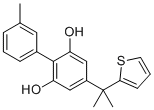
SMM-295
CAS No. 1054451-22-7
SMM-295( SMM295 | SMM 295 )
Catalog No. M10252 CAS No. 1054451-22-7
A novel potent, selective cannabinoid receptor 2 (CB2) agonist with Ki of 12 nM.
Purity : >98% (HPLC)
 COA
COA
 Datasheet
Datasheet
 HNMR
HNMR
 HPLC
HPLC
 MSDS
MSDS
 Handing Instructions
Handing Instructions
| Size | Price / USD | Stock | Quantity |
| 100MG | Get Quote | Get Quote |


|
| 200MG | Get Quote | Get Quote |


|
| 500MG | Get Quote | Get Quote |


|
| 1G | Get Quote | Get Quote |


|
Biological Information
-
Product NameSMM-295
-
NoteResearch use only, not for human use.
-
Brief DescriptionA novel potent, selective cannabinoid receptor 2 (CB2) agonist with Ki of 12 nM.
-
DescriptionA novel potent, selective cannabinoid receptor 2 (CB2) agonist with Ki of 12 nM, >30-fold selectivity over CB1; reduces cAMP production with a 66-fold selectivity for the CB2 versus the cannabinoid receptor 1 (CB1) in HEK-293 cells; reduces tubular damage and plasma markers of renal dysfunction (i.e., creatinine and NGAL) in acute kidney injury mice.
-
In Vitro——
-
In Vivo——
-
SynonymsSMM295 | SMM 295
-
PathwayGPCR/G Protein
-
TargetCannabinoid Receptor
-
RecptorCannabinoid Receptor
-
Research Area——
-
Indication——
Chemical Information
-
CAS Number1054451-22-7
-
Formula Weight324.438
-
Molecular FormulaC20H20O2S
-
Purity>98% (HPLC)
-
Solubility——
-
SMILES——
-
Chemical Name3'-methyl-4-(2-(thiophen-2-yl)propan-2-yl)-[1,1'-biphenyl]-2,6-diol
Shipping & Storage Information
-
Storage(-20℃)
-
ShippingWith Ice Pack
-
Stability≥ 2 years
Reference
1. Pressly JD, et al. J Pharmacol Exp Ther. 2017 Nov 29. pii: jpet.117.245522.
molnova catalog



related products
-
AM-2232
AM-2232 is a potent and unselective agonist of the cannabinoid receptors.
-
GP 1a
GP 1a is a potent agonist of cannabinoid receptor 2 (CB2) (EC50=7.1), as shown in cAMP, GTPγS and β-arrestin recruitment assays.
-
Otenabant hydrochlor...
A potent, and selective CB1 receptor antagonist with Ki of 0.7 nM/0.12 nM in binding and functional assays respectively.



 Cart
Cart
 sales@molnova.com
sales@molnova.com


